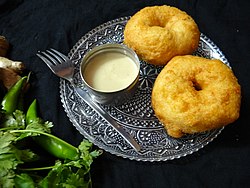 Medu vadas served with coconut chutney | |
| Alternative names | wada, vade, vadai, bara |
|---|---|
| Course | breakfast, snack |
| Place of origin | India |
| Region or state | India, Sri Lanka, Pakistan, Bangladesh, Singapore, Malaysia, Myanmar, Trinidad and Tobago, Guyana, Suriname, South Africa, [1] Mauritius, Fiji |
| Similar dishes | Burmese fritters |
Vada [a] is a category of savoury fried snacks native to India. Vadas can be described variously as fritters, cutlets, or dumplings. [2] [3] Vadas are sometimes stuffed with vegetables and traditionally served with chutneys and sambar.
Contents
In North India and Pakistan, bhalla is a similar food. It is sold in chaat shops and kiosks; green bean paste is added with spices, which is then deep-fried to make croquettes. They are then garnished with dahi (yogurt), saunth chutney (dried ginger and tamarind sauce) and spices. Bhalla is usually served cold, unlike the aloo tikki.
The various types of vadas are made from different ingredients, ranging from legumes (such as medu vada of South India) to potatoes (such as batata vada of Maharashtra). They are often served as a breakfast item or a snack, and also used in other food preparations (such as dahi vada, vada pav, and doubles).












